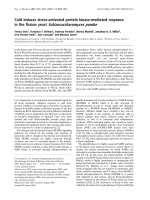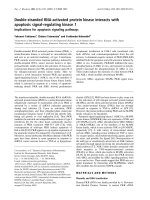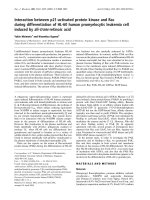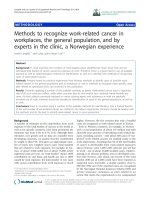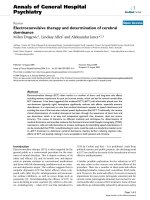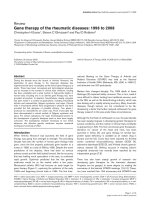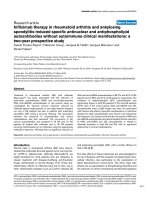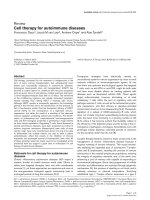Báo cáo y học: "Rituximab therapy reduces activated B cells in both the peripheral blood and bone marrow of patients with rheumatoid arthritis: depletion of memory B cells correlates with clinical response" potx
Bạn đang xem bản rút gọn của tài liệu. Xem và tải ngay bản đầy đủ của tài liệu tại đây (455.63 KB, 8 trang )
Open Access
Available online />Page 1 of 8
(page number not for citation purposes)
Vol 11 No 4
Research article
Rituximab therapy reduces activated B cells in both the peripheral
blood and bone marrow of patients with rheumatoid arthritis:
depletion of memory B cells correlates with clinical response
Magda Nakou
1
*, Georgios Katsikas
1
*, Prodromos Sidiropoulos
1
, George Bertsias
1
,
Eva Papadimitraki
1
, Amalia Raptopoulou
1
, Helen Koutala
2
, Helen A Papadaki
3
, Herakles Kritikos
1
and Dimitrios T Boumpas
1
1
Department of Rheumatology, Clinical Immunology and Allergy, University of Crete, Medical School, Voutes 71500, Heraklion, Greece
2
Laboratory of Flow Cytometry, University of Crete, Medical School, Voutes 71500, Heraklion, Greece
3
Department of Hematology, University of Crete, Medical School, Voutes 71500, Heraklion, Greece
* Contributed equally
Corresponding author: Dimitrios T Boumpas,
Received: 3 Feb 2009 Revisions requested: 13 Mar 2009 Revisions received: 30 Jun 2009 Accepted: 28 Aug 2009 Published: 28 Aug 2009
Arthritis Research & Therapy 2009, 11:R131 (doi:10.1186/ar2798)
This article is online at: />© 2009 Nakou et al.; licensee BioMed Central Ltd.
This is an open access article distributed under the terms of the Creative Commons Attribution License ( />),
which permits unrestricted use, distribution, and reproduction in any medium, provided the original work is properly cited.
Abstract
Introduction Bone marrow (BM) is an immunologically
privileged site where activated autoantibody-producing B cells
may survive for prolonged periods. We investigated the effect of
rituximab (anti-CD20 mAb) in peripheral blood (PB) and BM B-
cell and T-cell populations in active rheumatoid arthritis (RA)
patients.
Methods Active RA patients received rituximab (1,000 mg) on
days 1 and 15. PB (n = 11) and BM (n = 8) aspirates were
collected at baseline and at 3 months. We assessed B-cell and
T-cell populations using triple-color flow cytometry.
Results Rituximab therapy decreased PB (from a mean 2% to
0.9%, P = 0.022) but not BM (from 4.6% to 3.8%, P = 0.273)
CD19
+
B cells, associated with a significant reduction in the
activated CD19
+
HLA-DR
+
subset both in PB (from 55% to
19%, P = 0.007) and in BM (from 68% to 19%, P = 0.007).
Response to rituximab was preceded by a significant decrease
in PB and BM CD19
+
CD27
+
memory B cells (P = 0.022).
These effects were specific to rituximab since anti-TNF therapy
did not reduce total or activated B cells. Rituximab therapy did
not alter the number of activated CD4
+
HLA-DR
+
and
CD4
+
CD25
+
T cells.
Conclusions Rituximab therapy preferentially depletes
activated CD19
+
HLA-DR
+
B cells in the PB and BM of active
RA patients. Clinical response to rituximab is associated with
depletion of CD19
+
CD27
+
memory B cells in PB and BM of RA
patients.
Introduction
Rheumatoid arthritis (RA) is a complex inflammatory autoim-
mune disease characterized by disturbances in T-cell and B-
cell functions. Clinical and animal studies highlight the multiple
roles of B cells in the development and severity of RA, includ-
ing production of autoantibodies, inflammatory cytokines such
as TNF and IL-6, and aberrant antigen presentation [1].
Recent data in animal models suggest that, among these
effects, the antigen-presenting capacity of B cells may be of
particular importance in RA pathogenesis [2].
Rituximab is a chimeric mAb against CD20 that induces a pro-
found depletion of B cells in the peripheral blood of RA
patients [3]; however, little is known about the qualitative and
quantitative aspects of deletion achieved in tissues including
the bone marrow (BM) and lymph nodes. Initial studies in
humans with RA suggest that B cells are also depleted in the
BM as well as in the synovium [4]; nevertheless, the depletion
is rather incomplete [5].
BM: bone marrow; DAS28: disease activity score of 28 joint counts; IL: interleukin; mAb: monoclonal antibody; PB: peripheral blood; RA: rheumatoid
arthritis; TNF: tumor necrosis factor.
Arthritis Research & Therapy Vol 11 No 4 Nakou et al.
Page 2 of 8
(page number not for citation purposes)
The BM is important for the biology of B cells as it represents
a site of B-cell differentiation and maturation. The BM is an
immunologically privileged site, where stroma promote B-cell
survival and thus may protect B cells from depleting therapies
[6]. We have previously described quantitative and qualitative
changes in the BM of RA patients, which could affect a variety
of BM resident cells including the B cells [7,8]. Furthermore,
based on gene expression studies of lupus patients, we have
reported that the BM may be more informative than peripheral
blood (PB) in differentiating active from inactive lupus patients
and in differentiating patients from control individuals [9]. In
the present article we explored the effect of rituximab treat-
ment on B-cell subpopulations in the periphery and in the BM
in a cohort of RA patients with resistant disease.
Materials and methods
Patients and treatment
Thirty-one RA patients with active disease (disease activity
score of 28 joint counts (DAS28) >5.1) despite treatment with
disease-modifying anti-rheumatic drugs including at least one
anti-TNF agent, were selected to receive rituximab. Patients
were followed in the Department of Rheumatology, Clinical
Immunology, and Allergy, University Hospital of Heraklion
(Greece).
PB and BM specimens were obtained from 11 consenting
patients without predefined selection criteria. Samples were
obtained at baseline and after 12 weeks of treatment. Rituxi-
mab was administered as a 1,000 mg intravenous infusion on
days 1 and 15 [3]. Seven RA patients starting anti-TNF agents
were used as controls for the immunological study. Patients
had not received steroids for at least 24 hours before PB and
BM sampling. Written informed consent was obtained from all
patients and healthy controls, and the study was approved by
the Ethics Committee of the University Hospital of Heraklion.
Clinical assessment
Clinical parameters (28 swollen and tender joint counts), func-
tional status (Health Assessment Questionnaire), and labora-
tory parameters were regularly assessed every 2 months. The
DAS28 was applied to assess clinical efficacy [10]. The Euro-
pean League Against Rheumatism response criteria based on
DAS28 were used to assess the response to therapy [11].
Isolation of mononuclear cells and flow cytometry
PB mononuclear cells and BM mononuclear cells were iso-
lated by Ficoll-Histopaque (Sigma-Aldrich, St Louis, MO,
USA) density-gradient centrifugation of heparinized samples.
Cells (5 × 10
5
) were stained with the appropriate amounts of
fluorochrome-conjugated monoclonal antibodies for 30 min-
utes on ice. Combinations of anti-CD19, anti-HLA-DR, anti-
CD27, anti-CD38 and anti-CD45 staining were used for anal-
ysis of B cells. For analysis of T cells, anti-CD3, anti-CD4, anti-
HLA-DR, and anti-CD69 staining was performed. IgG isotype
controls were used in all experiments to determine the posi-
tively-stained cell population. Antibodies to CD19, CD69,
CD27, CD45, and CD38 were purchased from Immunotech
(Marseille, France), and anti-HLA-DR, anti-CD4, anti-CD3 anti-
bodies were purchased from eBioscience (San Diego, CA,
USA).
At least 200,000 events were collected in the lymphocyte gate
for analysis in an Epics Elite flow cytometer (Coulter, Miami,
FL, USA). Lymphocyte subsets were defined as follows: naïve
B cells, CD19
+
CD27
-
; memory B cells, CD19
+
CD27
+
; acti-
vated B cells, CD19
+
HLA-DR
+
; activated T cells, CD4
+
HLA-
DR
+
, CD4
+
CD25
+
, CD4
+
CD69
+
. Owing to the low propor-
tion of CD19
+
cells, all analyses were performed in constant
numbers of CD19
+
-gated cells.
Statistical analysis
The Statistical Package for Social Sciences (version 16.0;
SPSS Inc., Miami, FL, USA) was used in all analyses. Compar-
isons between independent groups were performed using
Student's t test, and paired samples were compared using the
paired t test. The nonparametric Wilcoxon signed-ranks test
was used for small (n < 10) sample sizes. Two-tailed P < 0.05
was considered statistically significant. Data are presented as
mean ± standard error of the mean. Absolute numbers of
CD19
+
B cells were calculated based on the total lymphocyte
numbers in the patient's complete blood count test results,
according to the following equation:
Results
Clinical characteristics of the patients and response to
rituximab therapy
The clinical and laboratory characteristics of the RA patients
who were treated with rituximab are summarized in Table 1.
Patients had longstanding (mean disease duration = 15 years)
and highly active disease (mean DAS28 = 6.3). All but one
patient had received at least one anti-TNF agent. Treatment
with rituximab reduced disease activity during the first 6
months; response rates (good and moderate) according to the
European League Against Rheumatism criteria were 45% at 4
and 6 months. Patient's baseline demographic characteristics,
disease activity indexes (DAS28, swollen/tender joint counts,
patient's perception of disease activity/pain, functional status),
rheumatoid factor levels and erythrocyte sedimentation rate
and C-reactive protein values were comparable between
responders and nonresponders (data not shown). Rheumatoid
factor levels after 4 months of treatment significantly
decreased from 253 ± 84 IU/l to 153 ± 80 IU/l (P = 0.001,
data not shown).
Rituximab therapy depletes B cells in peripheral blood,
but not bone marrow, of RA patients
Immunological studies were performed in 11 consenting
patients whose demographic and clinical characteristics were
Absolute number of CD cells l
absolute number of lymph
19
+
=/
(
μ
oocytes in complete blood count l percentage of CD ce/)(
μ
×
+
19 llls)
Available online />Page 3 of 8
(page number not for citation purposes)
comparable with the remaining patients who received
rituximab. We first assessed the effects of rituximab on B cells
in RA patients 3 months after therapy.
The percentage of PB CD19
+
B cells significantly decreased
in all patients from 2.2 ± 0.7% to 0.8 ± 0.3% (P = 0.022) (Fig-
ure 1a, b). In seven out of 11 patients (64%), complete
(>97%) B-cell depletion was noted (Figure 1a). Accordingly,
absolute B-cell numbers decreased from 58 ± 12 cells/μl to
17 ± 6 cells/μl (P = 0.030) (data not shown). In the BM, how-
ever, the effect of rituximab on B cells was less pronounced.
Rituximab therapy caused a reduction - but not depletion - of
BM B cells in only five RA patients, and overall the mean per-
centage of BM B cells was not reduced (from 4.6 ± 1.8% to
3.8 ± 0.7%, P = 0.273) (Figure 1a). We found no correlation
between depletion of B cells in PB or in BM and the clinical
response to rituximab. Taken together, these results suggest
that the BM B cells are more resistant than PB B cells to anti-
CD20 mAb depleting therapy in patients with RA.
Rituximab preferentially depletes activated CD19
+
HLA-
DR
+
cells in peripheral blood and bone marrow of RA
patients
A key feature in RA pathogenesis is the aberrant antigen-pre-
senting capacity of B cells, contributing to chronic T-cell acti-
vation and perpetuation of inflammation in the joint. We
Table 1
Demographic and clinical characteristics of rheumatoid arthritis patients treated with rituximab
Age (years) 62 (1.8)
Female (%) 61
Disease duration (years) 15 (2.8)
Previous therapies
Number of disease-modifying anti-rheumatic drugs used 2.6 (1 to 5)
Number of biologic agents used 1.6 (0 to 3)
Baseline disease characteristics
Rheumatoid factor-positive (%) 52
Disease activity score of 28 joint counts 6.3 (0.2)
Swollen joints (28 joints) 9.3 (1.1)
Tender joints (28 joints) 12.8 (1.3)
Patient's pain assessment 69.7 (2.9)
Patient's global assessment 67.3 (3.3)
Physician's global assessment 54.8 (3.4)
Health Assessment Questionnaire 0.9 (0.09)
Erythrocyte sedimentation rate (mm/hour) 51 (6.1)
Hemoglobin (g/dl) 12.9 (0.4)
Concomitant disease-modifying anti-rheumatic drugs
Methotrexate
Patients (%) 68
Dose (mg/week) 16.3 (7.5 to 25)
Leflunomide
Patients (%) 29
Dose (mg/day) 17 (10 to 20)
Glucocorticoids
Patients (%) 29
Dose (mg/day) 5.5 (5 to 10)
Rituximab monotherapy 3
Data expressed as mean (standard error of the mean), percentage, or mean (range); n = 31.
Arthritis Research & Therapy Vol 11 No 4 Nakou et al.
Page 4 of 8
(page number not for citation purposes)
therefore assessed the effect of rituximab therapy on B-cell
HLA-DR expression, a marker of activation and antigen-pre-
senting function. The proportion of HLA-DR
+
cells within the
CD19
+
cell fraction in PB significantly decreased from 57 ±
12% to 18 ± 9% (P = 0.05) (Figure 1c, d). In contrast to the
total numbers of CD19
+
cells, a comparable reduction in the
percentage of HLA-DR
+
cells within the CD19
+
cell fraction
was observed in the BM of RA patients who received rituximab
(from 69 ± 11% to 20 ± 10%, P = 0.007) (Figure 1c). Rituxi-
mab therefore effectively and preferentially depletes activated
HLA-DR
+
B cells both in the PB and the BM of RA patients.
Favorable response to rituximab therapy preceded by a
decrease in CD19
+
CD27
+
memory B cells in peripheral
blood and bone marrow of RA patients
We next examined the effect of rituximab therapy on memory
(CD19
+
CD27
+
) B cells, the precursors of autoantibody-pro-
ducing plasma cells. The mean percentage of memory B cells
in RA patients did not change (26 ± 5% at baseline vs. 26 ±
9% at 12 weeks; data not shown); accordingly, absolute num-
bers of CD27
+
B cells did not differ between baseline and 3
months post-treatment (11 ± 5 cells/μl vs. 6 ± 3 cells/μl). Nev-
ertheless a differential effect was observed according to clini-
cal response to therapy. Patients with a moderate-to-good
response to rituximab at 6 months (n = 4) therefore had a pre-
ceding significant decrease in PB CD19
+
CD27
+
B cells at 12
weeks from 30 ± 7% to 9 ± 5% (P = 0.022) (Figure 2). In con-
trast, in patients who did not respond to rituximab, an increase
in PB memory B cells was observed (from 23 ± 8% to 39 ±
13%). Interestingly, similar changes were found in BM
CD19
+
CD27
+
memory B cells; these B cells decreased by 26
± 10% in responders (n = 2) but increased by 31 ± 13% in
nonresponders (n = 4). Taken together these data suggest
that response to rituximab therapy is preceded by a significant
Figure 1
Effect of rituximab on B cells in rheumatoid arthritis peripheral blood and bone marrowEffect of rituximab on B cells in rheumatoid arthritis peripheral blood and bone marrow. Rituximab preferentially depletes B cells in peripheral blood
(PB) and reduces activated B cells in the PB and the bone marrow (BM) of rheumatoid arthritis (RA) patients. (a) The percentage of PB (n = 11)
CD19
+
B cells was significantly reduced following 3 months of treatment with rituximab. A nonsignificant reduction in B cells was also observed in
the BM (n = 8) of RA patients. (b) Representative flow cytometry analysis of PB CD19
+
B cells in a RA patient at baseline (left) and after 12 weeks
of rituximab treatment (right). (c) Rituximab depletes activated CD19
+
HLA-DR
+
B cells both in the PB and in the BM of RA patients. (d) Represent-
ative flow cytometry histograms of HLA-DR expression in PB and BM CD19
+
-gated cells of a RA patient at baseline and after treatment with rituxi-
mab. *P < 0.05 for paired analysis, **P < 0.05.
Available online />Page 5 of 8
(page number not for citation purposes)
decrease in the population of memory B cells both in the PB
and in the BM of RA patients.
Depletion of total and activated B cells is a specific effect
of rituximab therapy
To test whether B-cell depletion is specific to rituximab, we
examined the effect of anti-TNF therapy on B cells in the PB of
RA patients with active disease. After 12 weeks, anti-TNF-
treated patients displayed only a marginal decrease in PB
CD19
+
B cells from 7 ± 3% to 6 ± 1% (P = 0.670) (Figure
3a). Anti-TNF therapy had no effect on activated CD19
+
HLA-
DR
+
cells (from 83 ± 14% to 94 ± 2%) and on memory
CD19
+
CD27
+
B cells (from 44 ± 9% to 34 ± 4%, P = 0.171).
Finally, we examined the effect of rituximab on activated CD4
+
T cells by measuring the expression of the activation markers
CD25 and HLA-DR by flow cytometry. We found no signifi-
cant change in the percentage of CD4
+
CD25
+
T cells (from
11 ± 2% to 7 ± 1%, P = 0.563) and CD4
+
HLA-DR
+
T cells
(from 7 ± 2% to 5 ± 1%, P = 0.667) 12 weeks after rituximab
treatment (Figure 3b). Changes in CD4
+
T-cell markers did not
correlate with the degree of B-cell depletion or response to
therapy.
Discussion
In the present study, we investigated the effects of rituximab
on PB and BM lymphocyte subsets in patients with active RA.
Rituximab effectively reduced CD19
+
B cells in the PB of
patients; a less pronounced effect was observed in the BM.
Importantly, rituximab therapy preferentially depleted activated
CD19
+
HLA-DR
+
B cells in both compartments. The relative
low clinical response rate in our population probably reflects
the fact that these patients represent the most severe and
refractory subset among our cohort, with several of them hav-
ing failed multiple biologic therapies.
Expression and signaling through MHC class II molecules is
important for effective antigen presentation and induction of
co-stimulatory molecules on B cells [12]. Animal models of
inflammatory arthritis support an important role of B cells in
disease pathogenesis through a variety of mechanisms,
including aberrant antigen presentation and activation of auto-
reactive T cells in the joint [13]. HLA-DR
+
B cells have been
suggested to be important for B-cell-mediated T-cell activa-
tion; depletion of HLA-DR
+
cells could therefore represent an
additional mechanism for the beneficial effects of rituximab in
RA.
The BM is a primary lymphoid organ where B-cell differentia-
tion and maturation occurs; BM stroma promote B-cell survival
and protect B cells from depleting therapies [14,15]. In
accordance with this observation, we found that rituximab
therapy efficiently reduced PB CD19
+
B cells but had only a
weak effect on BM CD19
+
B cells. The change in BM B cells
did not correlate with clinical response to therapy or other dis-
ease parameters in the small patient number tested.
Previous studies have suggested the depleting effect of rituxi-
mab may be more pronounced in the PB than in inflamed tis-
sues or lymphoid organs. Kavanaugh and colleagues found
that - unlike PB B cells, which were profoundly (>95%)
depleted after rituximab therapy - synovial B cells decreased
but were not eliminated [16]. Similarly, in 24 RA patients who
received rituximab, PB B cells were depleted at 4 weeks
whereas synovial B cells were only moderately reduced and
persisted in five patients [5]. Local tissue expression of B-cell
survival factors (for example, B-cell activation factor belonging
to the TNF family, stromal cell-derived factor-1, macrophage
migration inhibitory factor) [17-19] might explain the relative
resistance of B cells against the depleting effect of rituximab.
Moreover, data both from animal models [20] and from
humans [4,21] have shown that the effect of B-cell depleting
therapies in lymphoid organs is variable. To this end, Teng and
colleagues found that only 32% of RA patients had complete
depletion of CD19
+
cells within the BM as compared with
100% in the PB [4]. Leandro and colleagues reported a varia-
ble degree of B-cell depletion within the BM [21].
In our cohort, four out of 11 patients had incomplete B-cell
depletion in PB - a relatively high proportion compared with
that observed by other studies. Nevertheless, resistance to
rituximab has been described in autoimmune-prone animals. In
MRL/lpr mice and in NOD mice it has therefore been shown
Figure 2
Correlation of clinical response to rituximab with depletion of CD19
+
CD27
+
memory B cellsCorrelation of clinical response to rituximab with depletion of
CD19
+
CD27
+
memory B cells. Clinical response to rituximab corre-
lates with depletion of CD19
+
CD27
+
memory B cells in peripheral
blood (PB) and in the bone marrow (BM) of rheumatoid arthritis (RA)
patients. PB CD19
+
CD27
+
cells increased by 29 ± 16% in nonre-
sponders (NR) (n = 5), compared with a reduction by 26 ± 10% in
responders (R) (P = 0.023) (n = 4). Similarly, BM CD19
+
CD27
+
cells
increased by 31 ± 13% in NR (n = 4), whereas they decreased by 26
± 13% in R (n = 2). *P < 0.05 for paired analysis between baseline and
3 months.
Arthritis Research & Therapy Vol 11 No 4 Nakou et al.
Page 6 of 8
(page number not for citation purposes)
that B cells are relatively refractory to depletion compared with
nonautoimmune-prone strains [20,22]. In lupus-prone mice,
high doses and extended duration of rituximab has been
shown to overcome resistance to depletion; while in NOD
mice, deficient FcγRI binding to IgG
2a
CD20 mAbs and
reduced splenic monocyte numbers have been implicated in
impaired B-cell depletion. The importance of FcγR in antibody-
dependent cell-mediated cytotoxicity as a mechanism for B-
cell depletion has been also shown in lupus patients treated
with rituximab [23]. Whether these mechanisms are involved
in reduced B-cell depletion in our patients needs to be
addressed.
The significance of incomplete B-cell depletion at the sites of
inflammation has not been fully determined, but investigators
have suggested that disease progression - despite PB B-cell
depletion - is probably due to survival of memory B cells, which
expand in secondary lymphoid tissues and produce autoanti-
bodies. In line with this hypothesis, Leandro and colleagues
reported that patients who relapsed early after repopulation of
PB B cells had a trend (P = 0.170) for a higher percentage of
CD19
+
CD27
+
memory B cells compared with those patients
that relapse later [24]. Roll and colleagues also performed
immunophenotyping in the PB of RA patients who received
rituximab, and reported a significantly higher proportion of
IgD
+
CD27
+
memory B cells during B-cell recovery in nonre-
sponders [25]. Moreover, Thurlings and colleagues found that
the reduction of synovial tissue plasma cells, which are nor-
mally derived by memory B cells, between weeks 4 and 16
after treatment predicted clinical improvement at 24 weeks
[5]. Accordingly, Möller and colleagues reported that low num-
bers of peripheral blood memory B cells (IgD
-
CD27
+
) corre-
lated with good clinical responses in RA patients treated with
rituximab [26].
Our data further support these findings since we observed a
significant decrease in CD19
+
CD27
+
memory B cells not only
in the PB but also in the BM of RA patients who subsequently
responded to rituximab. In contrast, memory B cells in nonre-
sponders remained stable or even increased in both compart-
ments. Together these data suggest that analysis of memory
B-cell subsets may provide important information on the effi-
Figure 3
Effect of anti-TNF treatment on peripheral blood B cells in rheumatoid arthritis patientsEffect of anti-TNF treatment on peripheral blood B cells in rheumatoid arthritis patients. (a) No effect of anti-TNF treatment on peripheral blood (PB)
CD19
+
cells, CD19
+
HLA-DR
+
cells, and CD19
+
CD27
+
cells in rheumatoid arthritis (RA) patients (n = 7). B-cell depletion is specific to rituximab
therapy. (b) Treatment with rituximab does not affect the proportion of total CD4
+
T cells, activated CD4
+
HLA-DR
+
T cells and CD4
+
CD25
+
T cells
in the PB of RA patients.
Available online />Page 7 of 8
(page number not for citation purposes)
cacy and response to rituximab therapy, consistent with the
notion that targeting cells with the memory phenotype is a key
determinant for its efficacy. Whether persistence of PB and/or
BM memory B cells is related to the lack of response after
rituximab retreatment observed in RA patients who did not
exhibit clinical improvement after the first treatment course
[27] remains to be determined.
Previous studies have indicated that rituximab may affect T-cell
responses in systemic lupus erythematosus patients through
downregulation of activation and co-stimulatory molecules (for
example, CD69, CD154). This effect was attributed to
decreased antigen-presenting function of B cells after rituxi-
mab treatment. We assessed the population of activated
CD4
+
CD25
+
and CD4
+
HLA-DR
+
T cells, but we found no
consistent changes according to response to therapy. Simi-
larly, Thurlings and colleagues found no effect of rituximab
therapy on PB CD4
+
or CD8
+
T cells of RA patients [5],
whereas Leandro and colleagues reported a decrease only in
a small subpopulation of CD3
+
CD20
+
cells while the total
CD4
+
subset and the activated CD4
+
subset remained unaf-
fected [24]. Nevertheless, an effect on T-cell activation/func-
tion cannot be excluded. Therefore, although B-cell depletion
in an animal study had no effect on T-cell subsets and activa-
tion markers, it impaired adaptive and autoreactive CD4
+
T-cell
activation [28].
Of note in small uncontrolled trials of systemic lupus erythema-
tosus patients, it has been reported that rituximab reduces
activated CD4
+
cells in parallel with B cells. To this end,
Sfikakis and colleagues reported that lupus patients respond-
ing to rituximab downregulated CD40 ligand, CD69 and HLA-
DR expression on CD4
+
cells [29], while Tokunaga and col-
leagues reported downregulation of CD40 ligand, inducible
costimulatory molecule (ICOS) and CD69 on CD4
+
-positive
cells in patients (n = 3) with active systemic lupus
erythematosus [30,31]. Whether the effect of rituximab on
activated T cells is disease specific remains to be seen.
Response rates according the European League Against
Rheumatism criteria (45% good and moderate responders)
were moderate in our cohort. Nevertheless, this was a group
of RA patients who were highly active refractory to previous
treatment. All but one patient had failed in treatment with anti-
TNFα agents (up to three agents). Although we found no cor-
relation between clinical response and the degree of periph-
eral B-cell reduction, incomplete B-cell depletion (four out of
11 patients) could potentially be one of the reasons for lower
clinical responses.
Conclusions
Rituximab effectively reduced PB CD19
+
B cells in RA
patients whereas its effect was less pronounced in the BM.
Activated CD19
+
HLA-DR
+
cells were significantly reduced in
both compartments. Importantly, clinical response was associ-
ated with the persistence of memory B cells in both
compartments.
Competing interests
The authors declare that they have no competing interests.
Authors' contributions
MN carried out the immunological studies. GK participated in
the design and conduction of the study and drafted the manu-
script. PS participated in the design of the study, performed
the statistical analysis of the data and drafted the manuscript.
GB performed the statistical analysis of the data and drafted
the manuscript. EP carried out the immunological studies. AR
carried out the immunological studies and was involved in
patient care. HK was responsible for analysis of flow cytometry
experiments. HAP participated in the design of the study and
drafted the manuscript. HK participated in the design and con-
duction of the study, was involved in patient care and reviewed
the manuscript. DTB conceived of the study and participated
in its design and coordination.
Acknowledgements
The present project has been funded in part by the Hellenic Society of
Rheumatology. MN and GB are graduate students of the Graduate Pro-
gram of the Molecular Basis of Human Diseases.
References
1. Martinez-Gamboa L, Brezinschek HP, Burmester GR, Dorner T:
Immunopathologic role of B lymphocytes in rheumatoid arthri-
tis: rationale of B cell-directed therapy. Autoimmun Rev 2006,
5:437-442.
2. O'Neill SK, Glant TT, Finnegan A: The role of B cells in animal
models of rheumatoid arthritis. Front Biosci 2007,
12:1722-1736.
3. Edwards JC, Szczepanski L, Szechinski J, Filipowicz-Sosnowska
A, Emery P, Close DR, Stevens RM, Shaw T: Efficacy of B-cell-
targeted therapy with rituximab in patients with rheumatoid
arthritis. N Engl J Med 2004, 350:2572-2581.
4. Teng YK, Levarht EW, Hashemi M, Bajema IM, Toes RE, Huizinga
TW, van Laar JM: Immunohistochemical analysis as a means to
predict responsiveness to rituximab treatment. Arthritis
Rheum 2007, 56:3909-3918.
5. Thurlings RM, Vos K, Wijbrandts CA, Zwinderman AH, Gerlag DM,
Tak PP: Synovial tissue response to rituximab: mechanism of
action and identification of biomarkers of response. Ann
Rheum Dis 2008, 67:917-925.
6. Minges Wols HA, Underhill GH, Kansas GS, Witte PL: The role of
bone marrow-derived stromal cells in the maintenance of
plasma cell longevity. J Immunol 2002, 169:4213-4221.
7. Kastrinaki MC, Papadaki HA: Mesenchymal stromal cells in
rheumatoid arthritis: biological properties and clinical
applications. Curr Stem Cell Res Ther 2009, 4:61-69.
8. Papadaki HA, Kritikos HD, Valatas V, Boumpas DT, Eliopoulos GD:
Anemia of chronic disease in rheumatoid arthritis is associ-
ated with increased apoptosis of bone marrow erythroid cells:
improvement following anti-tumor necrosis factor-alpha anti-
body therapy. Blood 2002, 100:474-482.
9. Nakou M, Knowlton N, Frank MB, Bertsias G, Osban J, Sandel CE,
Papadaki H, Raptopoulou A, Sidiropoulos P, Kritikos I, Tassiulas I,
Centola M, Boumpas DT: Gene expression in systemic lupus
erythematosus: bone marrow analysis differentiates active
from inactive disease and reveals apoptosis and granulopoie-
sis signatures. Arthritis Rheum 2008, 58:3541-3549.
10. Prevoo ML, van't Hof MA, Kuper HH, van Leeuwen MA, Putte LB
van de, van Riel PL: Modified disease activity scores that
include twenty-eight-joint counts. Development and validation
Arthritis Research & Therapy Vol 11 No 4 Nakou et al.
Page 8 of 8
(page number not for citation purposes)
in a prospective longitudinal study of patients with rheumatoid
arthritis. Arthritis Rheum 1995, 38:44-48.
11. van Gestel AM, Haagsma CJ, van Riel PL: Validation of rheuma-
toid arthritis improvement criteria that include simplified joint
counts. Arthritis Rheum 1998, 41:1845-1850.
12. Nabavi N, Freeman GJ, Gault A, Godfrey D, Nadler LM, Glimcher
LH: Signalling through the MHC class II cytoplasmic domain is
required for antigen presentation and induces B7 expression.
Nature 1992, 360:266-268.
13. O'Neill SK, Shlomchik MJ, Glant TT, Cao Y, Doodes PD, Finnegan
A: Antigen-specific B cells are required as APCs and autoanti-
body-producing cells for induction of severe autoimmune
arthritis. J Immunol 2005, 174:3781-3788.
14. Grammer AC, Lipsky PE: CD154 - CD40 interactions mediate
differentiation to plasma cells in healthy individuals and per-
sons with systemic lupus erythematosus. Arthritis Rheum
2002, 46:1417-1429.
15. Moser K, Tokoyoda K, Radbruch A, MacLennan I, Manz RA: Stro-
mal niches, plasma cell differentiation and survival. Curr Opin
Immunol 2006, 18:265-270.
16. Kavanaugh A, Rosengren S, Lee SJ, Hammaker D, Firestein GS,
Kalunian K, Wei N, Boyle DL: Assessment of rituximab's immu-
nomodulatory synovial effects (ARISE trial). 1: clinical and syn-
ovial biomarker results. Ann Rheum Dis 2008, 67:402-408.
17. Gore Y, Starlets D, Maharshak N, Becker-Herman S, Kaneyuki U,
Leng L, Bucala R, Shachar I: Macrophage migration inhibitory
factor induces B cell survival by activation of a CD74 - CD44
receptor complex. J Biol Chem 2008, 283:2784-2792.
18. Seki T, Selby J, Haupl T, Winchester R: Use of differential sub-
traction method to identify genes that characterize the pheno-
type of cultured rheumatoid arthritis synoviocytes. Arthritis
Rheum 1998, 41:1356-1364.
19. Tan SM, Xu D, Roschke V, Perry JW, Arkfeld DG, Ehresmann GR,
Migone TS, Hilbert DM, Stohl W: Local production of B lym-
phocyte stimulator protein and APRIL in arthritic joints of
patients with inflammatory arthritis. Arthritis Rheum 2003,
48:982-992.
20. Ahuja A, Shupe J, Dunn R, Kashgarian M, Kehry MR, Shlomchik
MJ: Depletion of B cells in murine lupus: efficacy and
resistance.
J Immunol 2007, 179:3351-3361.
21. Leandro MJ, Cooper N, Cambridge G, Ehrenstein MR, Edwards
JC: Bone marrow B-lineage cells in patients with rheumatoid
arthritis following rituximab therapy. Rheumatology (Oxford)
2007, 46:29-36.
22. Xiu Y, Wong CP, Bouaziz JD, Hamaguchi Y, Wang Y, Pop SM,
Tisch RM, Tedder TF: B lymphocyte depletion by CD20 mono-
clonal antibody prevents diabetes in nonobese diabetic mice
despite isotype-specific differences in Fc gamma R effector
functions. J Immunol 2008, 180:2863-2875.
23. Anolik JH, Campbell D, Felgar RE, Young F, Sanz I, Rosenblatt J,
Looney RJ: The relationship of FcgammaRIIIa genotype to
degree of B cell depletion by rituximab in the treatment of sys-
temic lupus erythematosus. Arthritis Rheum 2003, 48:455-459.
24. Leandro MJ, Cambridge G, Ehrenstein MR, Edwards JC: Recon-
stitution of peripheral blood B cells after depletion with rituxi-
mab in patients with rheumatoid arthritis. Arthritis Rheum
2006, 54:613-620.
25. Roll P, Dorner T, Tony HP: Anti-CD20 therapy in patients with
rheumatoid arthritis: predictors of response and B cell subset
regeneration after repeated treatment. Arthritis Rheum 2008,
58:1566-1575.
26. Möller B, Aeberli D, Eggli S, Fuhrer M, Vajtai I, Vogelin E, Ziswiler
HR, Dahinden CA, Villiger PM: Class-switched B cells display
response to therapeutic B-cell depletion in rheumatoid
arthritis. Arthritis Res Ther 2009, 11:R62.
27. Thurlings RM, Vos K, Gerlag DM, Tak PP: Disease activity-
guided rituximab therapy in rheumatoid arthritis: the effects of
re-treatment in initial nonresponders versus initial
responders. Arthritis Rheum 2008, 58:3657-3664.
28. Bouaziz JD, Yanaba K, Venturi GM, Wang Y, Tisch RM, Poe JC,
Tedder TF: Therapeutic B cell depletion impairs adaptive and
autoreactive CD4
+
T cell activation in mice. Proc Natl Acad Sci
USA 2007, 104:20878-20883.
29. Sfikakis PP, Boletis JN, Lionaki S, Vigklis V, Fragiadaki KG, Iniotaki
A, Moutsopoulos HM: Remission of proliferative lupus nephritis
following B cell depletion therapy is preceded by down-regu-
lation of the T cell costimulatory molecule CD40 ligand: an
open-label trial. Arthritis Rheum 2005, 52:501-513.
30. Tokunaga M, Fujii K, Saito K, Nakayamada S, Tsujimura S, Nawata
M, Tanaka Y: Down-regulation of CD40 and CD80 on B cells in
patients with life-threatening systemic lupus erythematosus
after successful treatment with rituximab. Rheumatology
(Oxford) 2005, 44:176-182.
31. Tokunaga M, Saito K, Kawabata D, Imura Y, Fujii T, Nakayamada S,
Tsujimura S, Nawata M, Iwata S, Azuma T, Mimori T, Tanaka Y:
Efficacy of rituximab (anti-CD20) for refractory systemic lupus
erythematosus involving the central nervous system. Ann
Rheum Dis 2007, 66:470-475.
